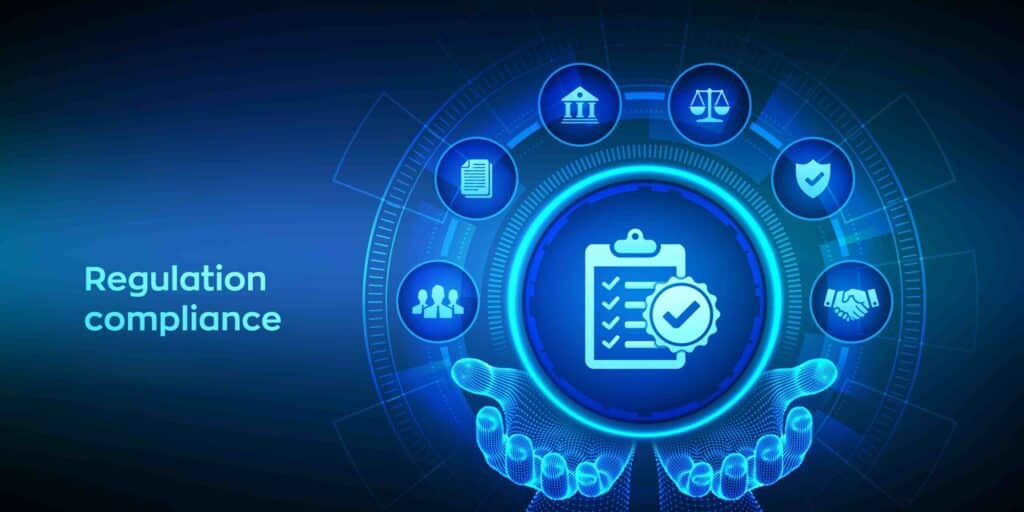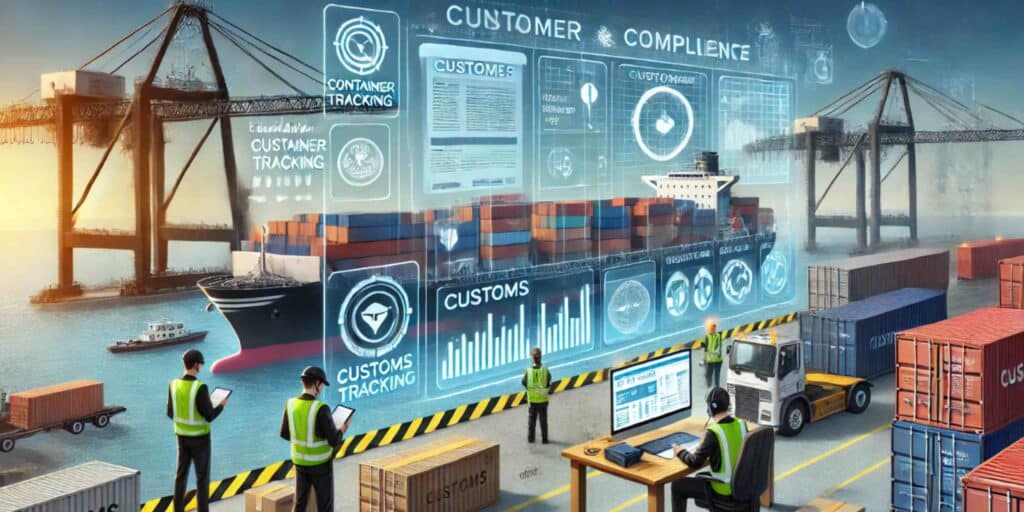With the complexity of global trade and logistics networks, organizations are increasingly turning to innovative solutions to streamline and optimize their supply chains. Nearly 90% of global trade is transported by sea, meaning even small delays can disrupt supply chains and impact businesses and consumers worldwide.
Container tracking is gaining traction as advancements in technology make it easier to monitor shipments, ensure regulatory compliance, and enhance supply chain transparency. By providing real-time insights into container locations and statuses, tracing systems help companies meet customs compliance requirements more efficiently, reducing the risk of delays due to regulatory issues. This article highlights how tracking and customs compliance work together to streamline logistics and guarantee efficient supply chains.
Understanding Container Tracking and Customs Compliance
Customs compliance means adhering to the trade regulations of the countries involved in your export and import activities. This includes understanding and following the laws and procedures established by national governments and multinational authorities to regulate international trade.
The Importance of Container Tracking
With millions of containers transporting valuable cargo globally, tracking them has become a vital necessity. It is crucial for effective management in worldwide trade, as it provides real-time information that enhances visibility, security, and operational efficiency. In a global logistics environment, knowing the exact location and status of goods allows companies to make informed decisions, prevent disruptions, and optimize supply chain operations.
Tracking data helps identify delays early, allowing for prompt adjustments and minimizing costly penalties such as detention and demurrage charges. In addition, secure monitoring reduces the risk of theft or loss, protecting valuable goods in transit. With precise tracking, companies can streamline processes, ensure compliance, and improve overall logistics management, resulting in a more reliable and efficient trade network.
Key Customs Compliance Requirements for Container Shipments
Regulations for containers are designed to ensure the safety, security, and environmental responsibility of global maritime transport. These rules encompass aspects like accurate tracking, proper documentation, customs procedures, cargo handling, and adherence to environmental standards. Common conformity requirements include:
Documentation: Accurate paperwork, such as bills of lading, commercial invoices, and packing lists, is essential. Any missing or incorrect information can hold up the shipment.
Tax Filings: Customs duties, import taxes, and tariffs must be declared and paid accurately. This will help avoid additional inspections.
Regulatory Checks: Compliance with international trade regulations, including safety standards and product certifications, is mandatory.
Having precise, immediate information on container status and contents will facilitate quicker customs clearance, ensuring efficient shipment processing.
How Container Tracking Enhances Customs Compliance
Based on a survey, 70% of consumers experienced delays, with 35% of those disruptions occurring without any reason provided. Therefore, improving shipping visibility and accountability offers businesses a key opportunity to prevent unexpected issues. Real-time visibility into container locations and statuses allows tracking systems to give businesses and customs officials access to vital shipment details before arrival at the port.
This transparency ensures that required documents are prepared and submitted promptly, reducing the risk of disruptions due to missing information. Automated alerts also notify stakeholders about any potential issues, allowing for swift corrective action. Additionally, tracking data supports adherence to regulatory requirements, helping companies avoid fines and maintain smooth customs clearance processes.
Key Challenges
The container industry drives global trade, linking economies and supporting business growth worldwide. However, as with any complex system, it encounters various challenges that affect its efficiency and reliability.
Data Management and Transparency Issues
One of the most significant challenges is data management and transparency, which is complex and involves multiple stakeholders, systems, and processes across the supply chain. Accurate and transparent data is crucial, but achieving this is challenging due to inconsistencies between shipping companies, port authorities, agencies, and logistics providers.
Each party often uses different formats, making it difficult to maintain a unified view of shipment status. Errors in data exchange can lead to discrepancies, impacting regulatory compliance and causing costly hold-ups. Ensuring seamless management requires integrating instant tracking information with various platforms, enhancing visibility for all involved parties.

Security Risks and Regulatory Complexities
Another significant challenge is the security risks and regulatory complexities faced in inter-shipping. As the maritime industry rapidly digitizes, cargo theft, tampering, and unauthorized access remain persistent threats, particularly in high-risk regions.
Without proper monitoring systems, businesses risk stolen or damaged goods, leading to financial losses and legal issues. Moreover, varying international regulations further complicate operations. Each country enforces its own customs rules, safety standards, and documentation requirements, creating difficulties in ensuring conformity across multiple jurisdictions.
Managing these complexities demands accurate tracking and immediate information to guarantee shipments meet regulatory requirements while minimizing safety risks. Robust systems help safeguard cargo, streamline compliance processes, and reduce the potential for costly disruptions.
Delays and Costs Due to Non-Compliance
It is well-known that non-compliance with customs regulations can have severe consequences, leading to increased operational costs. The impact of compliance errors is far-reaching and includes:
Delays: Incorrect or missing documentation can result in shipments being held up at customs, causing delays in delivery and disrupting the supply chain.
Penalties: Non-compliance may lead to fines, additional fees, or other legal consequences, increasing costs and potentially damaging the business’s reputation.
Increased Operational Costs: Errors in customs declarations often require costly rework, such as reprocessing paperwork, correcting information, or reshipping goods.
Effective Container Tracking & Compliance Practices
The goal of customs compliance is to ensure that goods are accurately imported, exported, and processed in accordance with regulatory requirements. This ensures that illegal or unsafe goods are prevented from entering a country, fosters fair trade practices, and safeguards the interests of both exporting and importing countries.
Leveraging IoT for Accurate Tracking
Using Internet of Things (IoT) devices significantly improves tracking with continuous and precise updates on the location and status of containers. Some key IoT devices include:
GPS Trackers: Provide real-time location data, enabling accurate tracking of the container’s position anywhere along its journey.
Temperature Sensors: Monitor temperature fluctuations, ensuring sensitive goods such as pharmaceuticals or perishables are kept within required conditions.
Humidity Sensors: Track moisture levels to safeguard products vulnerable to humidity, such as electronics or textiles.
Cargo Motion Sensors: Detect any unauthorized movement or tampering with the container, reducing the risk of theft.
Door Sensors: Monitor whether the container has been opened, ensuring security and preventing unauthorized access.
Automation and AI in Customs Compliance Processes
Automation refers to the use of technology to perform tasks without human intervention, while AI (Artificial Intelligence) involves creating systems that can simulate human intelligence to analyze data, make decisions, and improve over time.
With automated systems, businesses can easily generate, submit, and track the necessary paperwork, ensuring accuracy and timeliness. AI-driven tools can analyze large volumes of data, identifying potential discrepancies or compliance issues before they become costly mistakes. By automating routine tasks, teams can focus on higher-level decision-making, enhancing overall operational efficiency. With AI, they can monitor and adapt to changes in regulations, ensuring continuous conformity with minimal manual intervention.
Ensuring Security and Privacy in Container Tracking
To comply with international privacy laws, such as the GDPR in Europe and CCPA in California, businesses need to implement robust security practices to protect sensitive shipment information and maintain customer trust.
Best practices for securing tracking data include:
Encryption: Using strong encryption methods to protect data both in transit and at rest, ensuring that only authorized parties can access it.
Access Control: Implementing strict access controls and authentication protocols to limit who can view or modify data.
Regular Audits: Conduct regular security audits to identify vulnerabilities and ensure compliance with privacy regulations like GDPR (General Data Protection Regulation) or CCPA (the California Consumer Privacy Act).
Data Minimization: Collecting only necessary details and anonymizing or pseudonymizing sensitive data to reduce privacy risks.
Secure Storage: Storing information in secure, compliant systems to protect it from unauthorized access or breaches.
Sinay’s Container Tracking Technology
Safecube represents a major step forward to revolutionize container tracking solutions. With this innovative technology and our expertise, we are elevating the standards of efficient and transparent supply chain management. By integrating Safecube’s advanced software, we offer a comprehensive platform that enhances ocean freight management with several distinct benefits:
Real-Time Visibility: Track containers from any carrier with real-time updates on location, status, and potential disruptions, ensuring better decision-making.
Centralized Data Access: Consolidate all carrier data into a single, refreshed endpoint, making it easy to manage and analyze shipment information.
Automated Alerts: Get immediate notifications on any changes or issues through our API, reducing the risk of unexpected disruptions.
Enhanced Customer Experience: Provide clients with accurate insights, improving operational efficiency and boosting client satisfaction.
Conclusion
As global trade expands, robust container tracking solutions and customs compliance have become fundamental aspects of the shipping and logistics industry. Maintaining conformity with customs requirements is crucial for importers and exporters to avoid fines and ensure smooth clearance processes.
FAQ about container tracking and compliance
Container tracking provides real-time visibility and detailed shipment data, ensuring accurate documentation and timely updates for customs authorities. This reduces delays and penalties associated with non-compliance.
Yes, tracking systems can alert businesses to potential issues, such as missing documents or delayed shipments, allowing for proactive resolution and smoother customs clearance.
Customs compliance requires accurate information on cargo contents, origin, destination, and value. Container tracking systems centralize and streamline this data, making it easier to prepare and submit required documentation.
While not always mandatory, many customs authorities recommend container tracking for efficient operations. In some cases, tracking compliance is required for specific industries or high-value goods.


